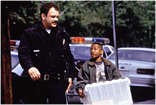Magnolia: An Appreciation

Screenwriting is a craft that occasionally rises to the level of an art. An art because there are times when it taps directly into the human heart, transcending time, place, language and culture. A craft because it depends upon form, concept, character and structure.
Magnolia pushes the form of the screenplay to another level. Why and how were the questions I wanted to ask. How did he structure the film and what were the elements that made it work? I hadn’t seen Magnolia when it was first released, and I hadn’t seen Boogie Nights or Hard Eight either, so I literally knew nothing about the work of Paul Thomas Anderson other than what I had heard or read about him. When I did finally get to see it, it was late in the afternoon and a light drizzle was falling. I jumped into my car, drove to the theater, walked inside, got my popcorn, found a seat and waited for the film to begin.
As the movie unfolded, I saw there were ideas here, ideas of death, of reconciliation and forgiveness, relationships between fathers and sons and fathers and daughters, relationships between chance, destiny and fate, and the interconnectedness of all things. Anderson’s style of filmmaking seemed more like poetry than a series of staged dramatic actions. As “unconventional” as it may seem, Magnolia has it’s own unique style and works incredibly well.
 When I talk about Magnolia in my seminars and workshops, some people object and tell me it’s too long. They say it’s too melodramatic. They tell me it pushes the boundaries of reality. Yes, thank God. It’s the brilliance of Anderson’s vision, the intelligence of the emotional tapestry that he weaves into his fluid style of filmmaking that makes it so powerful.
When I talk about Magnolia in my seminars and workshops, some people object and tell me it’s too long. They say it’s too melodramatic. They tell me it pushes the boundaries of reality. Yes, thank God. It’s the brilliance of Anderson’s vision, the intelligence of the emotional tapestry that he weaves into his fluid style of filmmaking that makes it so powerful.
Many people insist that Magnolia is an excellent example of an “unconventional” film because it doesn’t follow the “conventional” guidelines of structure, whatever that means. I confess that after all these years of studying and thinking and teaching thousands and thousands of people about the movies, I still don’t know what the phrase “conventional structure” really means. When people insist on telling me how unconventional it is, and ask if I think it still follows structure, I reply definitely, pointing out that “form follows structure;” structure is only the start point, not the end point.
It may seem that Magnolia is a fragmented, nonlinear story experience but that’s not the case at all. The nine stories told in Magnolia are all connected and related to each other. The actions of each character are superimposed, one on the other, and the film’s structure begins at the beginning of the day and ends with Earl’s death, at the end of the day.

As I began to see the connections of the individual stories I had the image of an old wagon wheel, where the hub at the center connects all nine spokes to the outer rim. That image stayed with me as I began analyzing the film; Earl is the hub of the story and his past actions are the glue that holds the story together in terms of the present. Earl’s guilt at leaving his wife so many years before, letting his 14 year old son, Frank, take care of his dying mother, has paid a heavy price on Earl’s conscience. The dying man has hidden that fact, and only now, as the cancer eats away at him, riddled with pain and memory, does he seek forgiveness.
It’s pretty clear Magnolia deals with the themes of reconciliation and forgiveness, revealing what the parent’s past actions have wrought upon their children. Ibsen’s great play, Ghosts, deals with this same theme, the sins of the father passed onto the son. Certainly, this is the subject of Earl’s incredible death bed monologue as he confesses his “sins” to Phil, telling him he walked out on his wife and son, leaving Frank to tend to his dying mother. “It’s the biggest regret of my life,” he says.

When I first saw this scene, I was taken aback. To have the characters break into song, expressing their pain and discomfort in a musical lyric, is an extraordinary accomplishment. I remember James Brooks tried to do this in “I’ll Do Anything,” and it didn’t work. Finally, after several different approaches in cutting the movie, Brooks had to drop the songs and tried to structure the film in a different way. But it never really worked. Paul Anderson makes it work.
Then, there are the frogs. I didn’t know quite what to make of this when I first saw it. But I love this collision of reality and unreality. I learned this while working with one of my students, the brilliant Mexican screenwriter, Laura Esquivel; Laura taught me about the heritage of the Mexican literary tradition known as “magic realism.” Working with her on the screenplay of Like Water For Chocolate, I was introduced to this concept of “exaggerated reality,” where the clash of reality and unreality blends into the framework of the story line.

In the end, as Jim Kurring tells us in his voice over narration “Sometimes people need a little help. Sometimes people need to be forgiven.” In the very last scene, Jim Kurring’s voice-over narration takes us to Claudia, and she has a long, vacant look into the camera. And then, she smiles. So simple, so bright, so elegant; I had not seen her smile once during the entire film. I was so moved to see that smile, after all the pain she’s lived in and been through, and reflects such a positive ending, that it brought tears to my eyes.
The voice over narrator sums it all up: “There are stories of coincidence and chance and intersections and strange things told and which is which who only knows.and we generally say, ‘Well if that was in a movie I wouldn’t believe it.’ And it is in the humble opinion of this narrator that these strange things happen all the time.and so it goes and so it goes and the book says, ‘We may be through with the past, but the past is not through with us.”
And so it goes and so it goes.


Comments are closed.